Early this year Alexander Rossi of Nevada City, rookie winner of the 2016 Indianapolis 500, met the seven pit-crew members of his new racing team during a let’s-get-to-know-each-other dinner. There, he learned his right-rear tire changer, Travis Peck, was only 19.
“Well, that sure brought the team’s average age down,” Rossi, 31, said to uproarious laughter from his teammates.
Since then, Rossi and crew have been bonding and working together to smooth the transition from his former team, Andretti Autosport, to his new team, Arrow McLaren. Though Arrow McLaren is a relatively new team in the IndyCar world, it’s part of world-famous Formula 1 powerhouse McLaren Racing. McLaren returned to the NTT IndyCar Series (sponsored by Japanese company Nippon Telegraph and Telephone) full time in 2020.
“It’s been a little bit of a ‘first-day-of-school’ experience,” says Rossi, the first American to win the historic Indy 500 on his first try since 1927, claiming its $2.1 million, first-place prize in only his second oval race.
During seven sensational seasons with Andretti, Rossi followed winning the 100th anniversary of Indy with seven additional victories, 28 top-three finishes, seven poles, and he placed second and third in championship points in 2018 and 2019, respectively.
For 2023, Rossi, in addition to switching teams, put it all on the checkered Start/Finish line by obtaining new sponsors, car numbers, liveries and engine suppliers.
The change is a bit of a homecoming.
A stellar start
Beginning at age 10, Rossi had numerous wins in Karts and related feeder-series events throughout Northern California and elsewhere before moving to Europe, at only 17, to pursue his dream to compete in Formula 1.
But after making only five starts in five years trying to secure a full-time ride in F1, he returned to the U.S. in 2016, where the Auburn-born California native qualified 11th at Indy’s 2.5-mile oval with an average speed of 228 mph as the junior member of a four-car Andretti squad overseen by former IndyCar champ Michael Andretti, son of racing legend Mario Andretti. That year, he became the first American rookie to win the Indianapolis 500 since 1927. The number of fans cheering his improbable victory numbered a first-ever sellout crowd of more than 350,000.
2016 Indy 500 winner Alexander Rossi of Nevada City with the
Borg-Warner Trophy at the yard of bricks that marks the
start/finish line at the Indianapolis Motor Speedway.
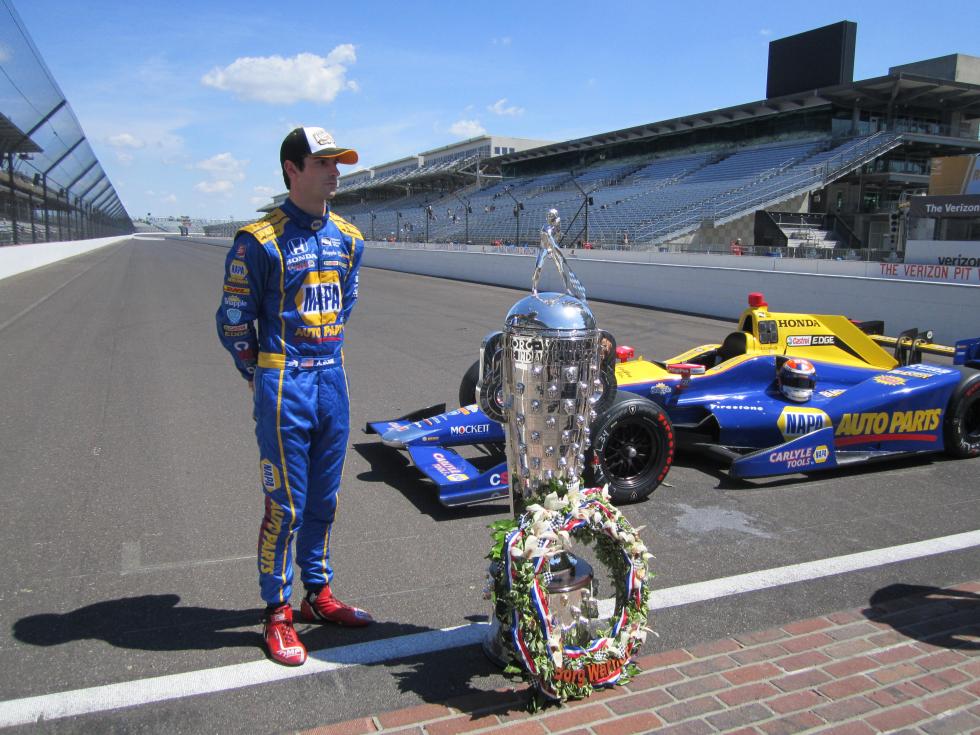
Rossi’s win at the 500 came after Andretti co-team owner and Rossi strategist Bryan Herta of Valencia gambled on fuel mileage, timing it so close Rossi ran out of methanol at the finish and had to be towed to Victory Circle.
Weeks later, during a Main Street parade in Rossi’s hometown northeast of Sacramento, family members, friends and fellow residents celebrating Rossi’s win on the track’s 100th anniversary totaled about 2,200.
When Rossi learned his hometown of 13,000 would host him after his unprecedented win at Indy, Rossi made an uncommon request: He asked Indianapolis Motor Speedway Museum officials if the nearly 5-foot-5, 110-pound Borg-Warner Trophy could be part of his welcome-home procession.
The sterling-silver trophy, easily the best-known monument to winning in motorsports, is familiar to racing fans worldwide for its sculpted, three-dimensional heads of the winners molded onto its sides. Rossi’s likeness is the 103rd winner to grace the art deco statue since its debut in 1936.
Valued at more than $4 million, the commemorative icon normally travels with something akin to a Secret Service-style security detail. This includes traveling in a custom trunk and workers wearing special gloves when handling the irreplaceable statue to protect its finish. With the trophy secured in the bed of the pickup and flanked by Rossi and two escorts, the trio waved and gave spectators free commemorative ball caps.
Like all Indy winners (and team owners), Rossi received an 18-inch-tall sterling silver replica of the trophy, fondly called the “Baby Borg.”
The next lap
In his debut for his new Indianapolis-based team last March at the season opener on the downtown street course in St. Petersburg, Florida, Rossi finished a strong fourth.
Afterward, Rossi described Arrow McLaren as “the little team that could” that now threatens to be a true title contender.
Rossi’s team change comes at a key time for open-wheel series rivals IndyCar and F1. The popularity of the two racing series is growing, and both are adding additional venues, promotions and teams. IndyCar is a U.S.-based, 17-event series that features a mix of ovals, superspeedways, road courses and temporary street circuits. F1 is an international series that competes this year on 24 road and street courses only, including three in the U.S.
Helping spur growing public interest in open-wheel racing is the popular Netflix F1 docuseries “Drive to Survive,” now in its fifth season. IndyCar, in turn, has begun promoting its own version, “100 Days to Indy,” a six-part series produced by VICE Media that began airing on The CW April 28.
The debuting IndyCar TV series promises to take fans behind the scenes to chronicle the “bold and brash” personalities of IndyCar. Rossi and his teammates — fourth-year driver Mexican Pato O’Ward (four career wins) and fifth-year pilot Felix Rosenqvist of Sweden (one win) — are certain to be part of the mix.
Herta said at last month’s Acura Grand Prix of Long Beach, which Rossi won in 2018 and 2019, that Rossi could be a natural focus for TV.
“He’s very funny and has a great sense of humor,” Herta said. “The thing about Alex is that he’s exactly what you see. He’s very honest and very direct. People want to see an authentic guy behind the helmet; you get exactly that with Alex.”
Herta added that he will miss Rossi being part of the Andretti team, especially at the May 28 edition of the 500, called the Greatest Spectacle in Racing because of its history, tradition and the 350,000 fans expected to attend, the largest single-day sporting event in the world. (By comparison, about 130,000 attend NASCAR’s biggest race, the Daytona 500).
“He contributed a lot in terms of his knowledge, his feel for the car,” Herta said of Rossi. “He was an important part of moving our (Andretti) team forward. We miss his experience a lot but I’m happy for him. He’s on a very good team and in a good situation. And he seems happy, and as his friend that’s what you want.
“I just hope he finishes fifth every week,” behind Andretti’s four cars, Herta adds, laughing.
Building on success
IndyCar’s new TV series is among a plethora of changes billionaire racing icon Roger Penske has initiated since buying the IndyCar Series and Indianapolis Motor Speedway three years ago, including the possibility of a new venue near Palm Springs. Penske’s promotional plans for 2023 promise to reach out to younger fans, and race teams, business leaders and organizers for California tracks have cited millions in economic benefits to cities and regions that host IndyCar events.
Long Beach officials, for example, say hosting a temporary downtown street course since the mid-1970s has helped transform a hard-edged Navy town filled with downtown strip joints, tattoo parlors and seedy bars into California’s version of glamorous Monaco on the coast of France. A recent study concluded the city’s annual Grand Prix had a $63 million impact to the region, with $32 million of that in the City of Long Beach.
Alexander Rossi in his new livery puts his No. 7 through a corner
during Spring Training last February at the new The Thermal Club
race track near Palm Springs.
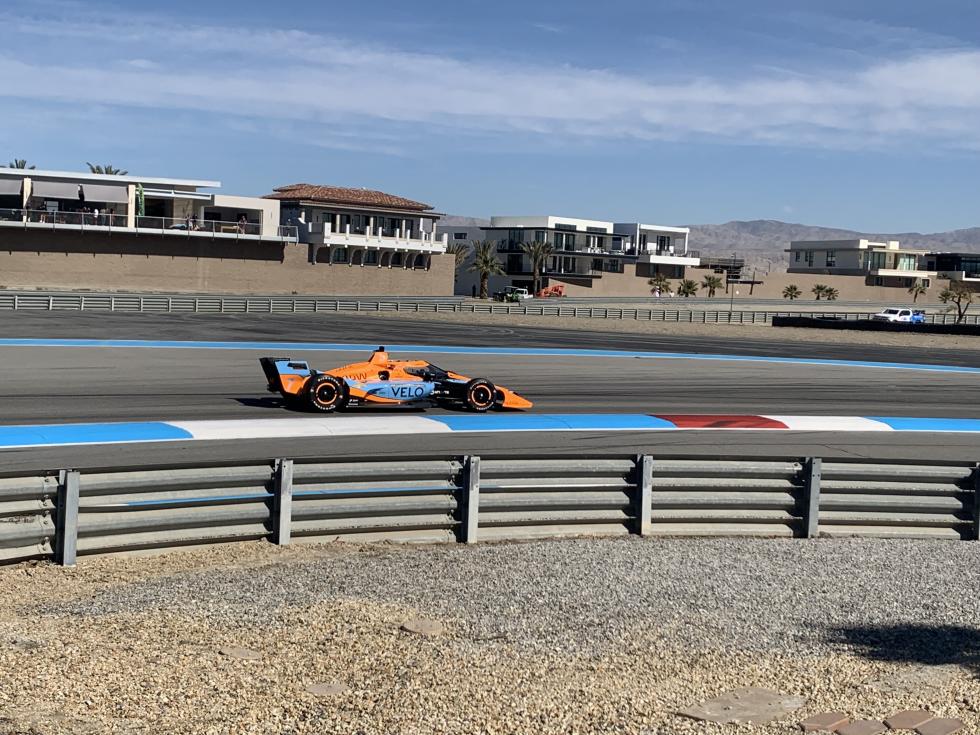
Closer to home, this year’s finale to IndyCar’s season will be Sept. 8-10 at another popular tourist destination, WeatherTech Raceway Laguna Seca, a twisty permanent road course known for its scenic beauty and gravity-defying, on-track elevation changes.
“The return of IndyCar to Monterey has been highly welcomed by our local businesses as an event staple in Monterey County,” says Barry Toepke, director of events and public relations at Laguna Seca. “The addition of our ‘local’ driver Alexander Rossi brings added interest from Sacramento and Central Valley motorsports fans.”
Toepke added that while watching the race live on the NBC Network is entertaining, “You have to be present to feel the tension and electricity of the season finale,” he says. “It was remarkable in 2022 and we hope people will enjoy it even more this September.”
Another promising sign of growth is how The Thermal Club, a 300-acre private race track amid an upscale housing development catering to millionaire car enthusiasts south of Palm Springs, hosted IndyCar Spring Training last February. Organizers hope Thermal becomes a permanent part of the series.
For most race fans, however, it is the 500 at IMS that by far is the biggest event on their must-watch calendar, and Rossi hopes to add to his record there of one win, a second and a fourth in seven tries at a track known for speeds above 230 mph.
Time and public interest will tell but it’s hard to say what the long-term impact Rossi and IndyCar will have on local, regional and statewide business, according to Stuart Baker, manager of the Nevada City Chamber of Commerce.
“It was a wonderful feel-good moment and we took great pride in Rossi’s win,” Baker says. “These things can have a massive, immediate economic impact. We will follow his career but in the long term, unless there’s something more, it’s hard to sustain interest.”
A second win by Rossi at Indy’s Brickyard would certainly warrant increased interest — and another parade, Baker says.
And perhaps a second Baby Borg.
–
Stay up to date on business in the Capital Region: Subscribe to the Comstock’s newsletter today.
Recommended For You
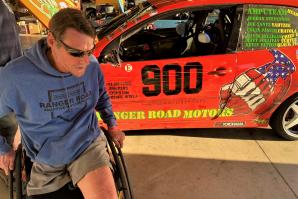
When Life Gives You Lemons, Race Them
Capital Region drivers join motorsports event showcasing cars under $500
When veterans participate in the irreverent race of old cars called 24 Hours of Lemons, they get a healthy dose of camaraderie, fun and a rush of adrenaline. Costumes and janky cars are just the beginning of what makes this eclectic race special.
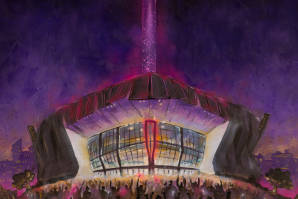
The Beam Effect
How the Sacramento Kings' purple beam stands for success both in and around the arena
When the Kings play and the Beam is lit, it means both the Kings and businesses in Downtown Commons and surrounding region are all prospering.
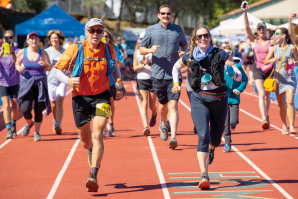
Going to Extremes
Endurance athletes push their bodies to the limit — and pump money into the regional economy
Extreme athletes see what they can accomplish, however improbable
— like the 100.2-mile ultramarathon Western States — and use
their hobbies to contribute to regional economies.
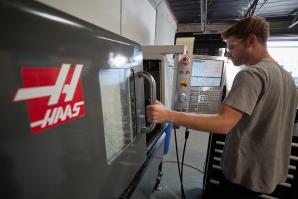
Trained in the Trades
Area companies and educators are developing much-needed middle-skill workers, but will low wages make it impossible to fill the void?
Industries around the Capital Region are feeling the pinch of trying to find qualified, skilled workers needed to fill various positions. Some companies are starting to reach out to trade programs to help fill those gaps.



